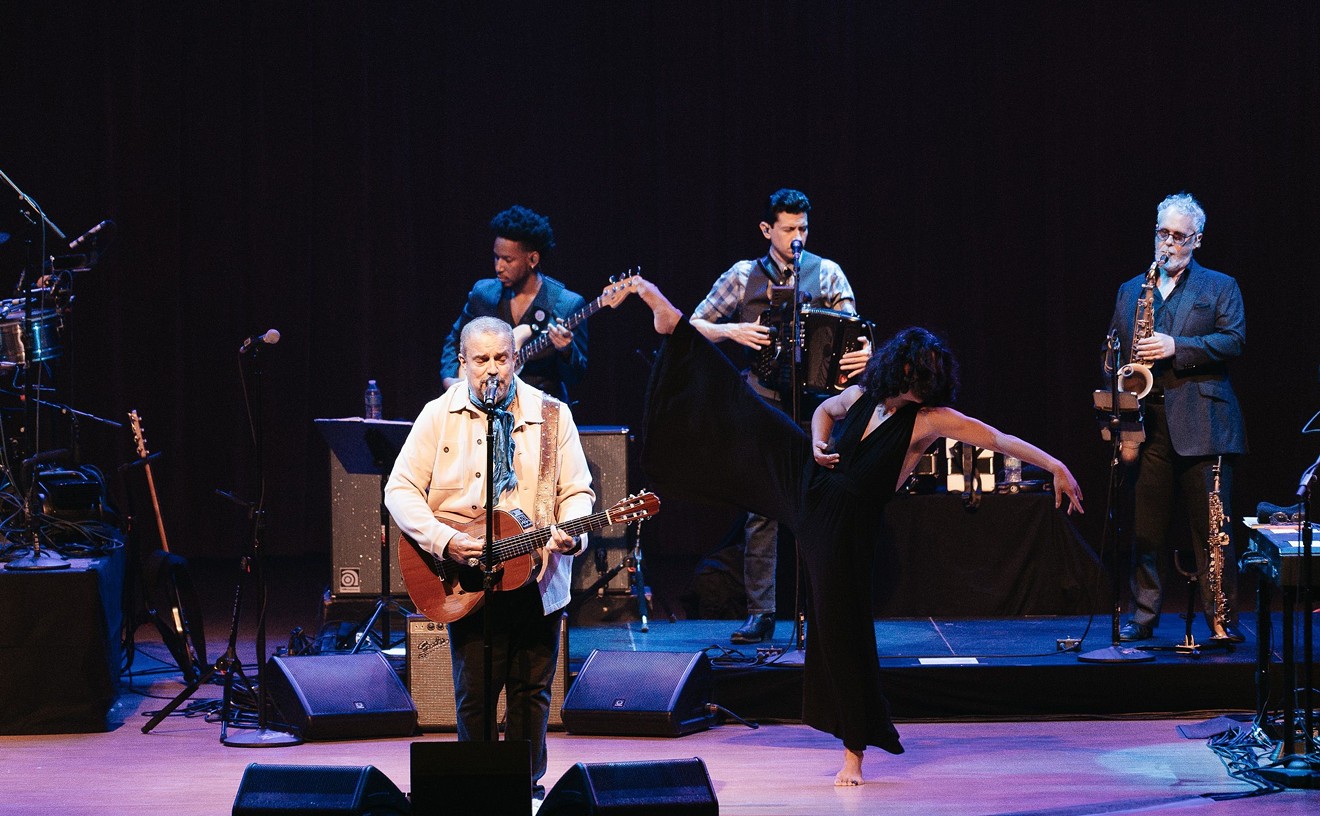Two exhibitions at two venues take a look at the phenomenon of outsider artist Purvis Young. One, titled simply "Purvis," is now winding down at the 12th Floor Art Space at Broward College (formerly Broward Community College) in downtown Fort Lauderdale. The other, called "Purvis Young: Raw," has a slightly longer run at Exor Galleries at Royal Palm Place in Boca Raton.
"Purvis" features 30 works selected by curator Janet Gold, an artist herself. They're taken from the substantial holdings of Larry Clemons, formerly Young's dealer, who has designated part of his Gallery 721 as the Purvis Young Museum. (Clemons, whose gallery is open by appointment only, also handles work by pop artist Peter Max, self-taught Southern artist Thornton Dial, and American folk artist the Rev. Howard Finster.) "Purvis Young: Raw" includes, coincidentally, another 30 works, selected from a private collection by Exor's in-house curator, Suzanne Khalil.
For the uninitiated, Purvis Young is perhaps the most celebrated and the most widely collected street artist of his generation. He was born in the Liberty City neighborhood of Miami in 1943 and now lives and works in the Overtown section of the city. Over the course of his life, he has witnessed the dramatic transition of Overtown from a cosmopolitan, multiracial community to one that's mostly black and plagued by poverty, drugs, and violence. Young observes this transformation again and again in his art.
The 2005 documentary Purvis of Overtown, which played at the 2007 Fort Lauderdale International Film Festival and is available on DVD, provides an excellent overview of the artist's life set against the evolution of Overtown. As chronicled in the film and elsewhere, Young was encouraged by his Bahamian mother to draw and continued to do so even during a jail stint as a teenager in Raiford State Prison for armed robbery.
Somewhere along the way, he began making more ambitious art using whatever materials he could get his hands on, including house paint, fragments of discarded furniture, scraps from contraction sites, and the like. Entirely self-taught in libraries and from public television and radio, Young has acknowledged favorite artists and influences as diverse as Daumier, El Greco, Picasso, Rembrandt, Rubens, and Van Gogh. (One of Young's nicknames is "Picasso of the Ghetto.")
By the early 1970s, Young had accumulated enough work to begin blanketing the walls along Goodbread Alley, a stretch of 14th Avenue in Overtown that was once home to a bakery. He has continued to generate amazing quantities of art ever since, although his more recent output has been curtailed by serious health problems.
Of the two current presentations of Young's work, curator Gold has had the greater challenge: working in Broward College's so-called 12th Floor Art Space, which is not so much a gallery as a series of interlocking spaces. She has risen to the challenge admirably, filling virtually every available spot in a large multipurpose room and the surrounding corridors with art. The cluster of adjacent administrative offices has also been pressed into service as display space.
Gold, a formally trained artist known for abstract painting and photography, might seem a surprising choice to curate a selection of Purvis Young's prolific output. To which I say, not really. Some of her own concerns as an artist these days — pattern and texture — have governed her selections for "Purvis," and they have served her well. Although Young's quintessentially urban themes and crude, unrefined style might seem a far cry from Gold's preoccupation with abstraction and recent work in small-scale collage, the two artists are oddly complementary. Gold also has a few works by Purvis in her own private collection, which suggests she's well-aware of their affinities.
Those affinities show up most prominently in the way Gold has been drawn to works, mostly from the 1980s and '90s, that emphasize their framing. Young has long been inclined to frame his own work with whatever is at hand — swatches of used carpet, for instance, or random pieces of wood that often still have nails sticking out of them. Indeed, Young's framing is sometimes as interesting as, or even more interesting than, the actual content of his paintings.
In "Purvis Young: Raw," at Exor Galleries, the works are also from the '80s and '90s, although the show has a decidedly different feel. There's a greater abundance of larger works, especially big horizontal images, and a lot of the paintings are left unframed. A few are professionally framed, which creates a tangible tension between the slick packaging and the intentional rawness of the paintings that can be shockingly effective, as in a pair of works executed in marker on tile.
In terms of content, Young has rarely strayed far from the iconography that has dominated his work from the beginning, a highly personal language that is limited and at the same time enormously expressive. Both exhibitions include abundant angel imagery, as well as horses and those trademark squiggly figures that seem to be writhing in either ecstasy or agony, depending on their circumstances. City buildings and street scenes are also common.
Despite a life that has been far from easy, Purvis Young has had an extraordinary artistic career by any standard. His work can be found in major museums throughout the country, and its market value has skyrocketed from a few dollars to tens of thousands. Among his regional benefactors are the Rubell family of Miami, whose world-class art collection includes thousands of pieces by Purvis, nearly a dozen of which were donated to the Boca Raton Museum of Art a couple of years ago for its landmark "Purvis Young: Paintings From the Street" retrospective. As I observed when I wrote about that show, in words that still hold true, it's a charmed if strange life.










